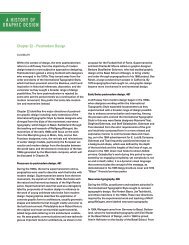Week 7 A New Language of Form - A History of Graphic Design
Week 7 A New Language of Form - A History of Graphic Design
Week 7 A New Language of Form - A History of Graphic Design
- No tags were found...
Create successful ePaper yourself
Turn your PDF publications into a flip-book with our unique Google optimized e-Paper software.
A HISTORY OFGRAPHIC DESIGN“art for art’s sake” to devote themselves to industrial design, visual communications, and applied arts serving the newcommunist society. This group called on artists to stop producing useless things such as paintings and turn to theposter, for “such work now belongs to the duty <strong>of</strong> the artist as a citizen <strong>of</strong> the community who is clearing the field <strong>of</strong>the old rubbish in preparation for the new life.” The three principles <strong>of</strong> this group’s work were tectonics, texture, andconstruction.Tectonics, page 301, the principle <strong>of</strong> constructivism that represented the unification <strong>of</strong> communist ideology with visualform.Texture, page 301, the principle <strong>of</strong> constructivism that dealt with the nature <strong>of</strong> materials and how they are used in industrialproduction.Construction, page 301, the principle <strong>of</strong> constructivism that symbolized the creative process and the search for laws <strong>of</strong>visual organization.PROUNS, page 301, an acronym for “projects for the establishment [affirmation] <strong>of</strong> a new art,” coined by El Lissitzkyto name his own painting style. He introduced three-dimensional illusions that both receded (negative depth) behindthe picture plane (naught depth) and projected forward (positive depth) from the picture plane. Lissitzky called this “aninterchange station between painting and architecture” (Fig. 15-8).Novyi lef (Left Front <strong>of</strong> the Arts), page 307, a magazine for all fields <strong>of</strong> the creative arts designed by Alexander Rodchenko.Overprinting, precise registration, and photomontage were regularly employed.Serial painting, page 309, a series or sequence <strong>of</strong> independent works unified by common elements or an underlyingstructure (Figs. 15-26 through 15-29c).Infantilism, page 313, the fresh, spontaneous, naive techniques <strong>of</strong> children’s art seen in Vladimir Vasilevich Lebedev’swork (Figs. 15-38 through 15-40).De Stijl, page 313, this movement sought universal laws <strong>of</strong> equilibrium and harmony for art, which could then be aprototype for a new social order. Its artists worked in an abstract, geometric style. Its founder and guiding spirit, Théovan Doesburg, was joined by painters Piet Mondrian, Bart Anthony van der Leck, and Vilmos Huszár, the architect JacobusJohannes Pieter Oud, and others. With their proscribed visual vocabulary, these artists sought an expression <strong>of</strong>the mathematical structure <strong>of</strong> the universe and the universal harmony <strong>of</strong> nature. They believed the war was expungingan obsolete age, and science, technology, and political developments would usher in a new era <strong>of</strong> objectivity and collectivism.(Figs. 15-41 through 15-45).De Stijl [journal], page 313, edited and published by Théo van Doesburg, this publication spread the De Stijl movement’stheory and philosophy to a larger audience. It advocated the absorption <strong>of</strong> pure art by applied art (Figs. 15-47 through15-48).Elementarism, page 314, Théo van Doesburg’s theory that declared the diagonal to be a more dynamic compositionalprinciple than horizontal and vertical construction.Mechano-faktura theory, page 320, developed by Henryk Berlewi, it mechanized painting and graphic design into aconstructed abstraction that abolished any illusion <strong>of</strong> three dimensions. This was accomplished by mathematical placement<strong>of</strong> simple geometric forms on a background. The mechanization <strong>of</strong> art was seen as an expression <strong>of</strong> industrialsociety (Fig. 15-61).Roklama Mechano, page 320, In 1924, Henryk Berlewi joined the futurist poets Aleksander Wat and Stanley Brucz inopening this Warsaw advertising firm. It introduced modern art forms to Polish society through industrial and commercialadvertisements (Fig. 15-62).Devětsil (Nine Forces), page 322, a group <strong>of</strong> avant-garde poets, designers, architects, performance artists, and musicianswho designed many <strong>of</strong> their publications using what was available in the letterpress printer’s type case.
















